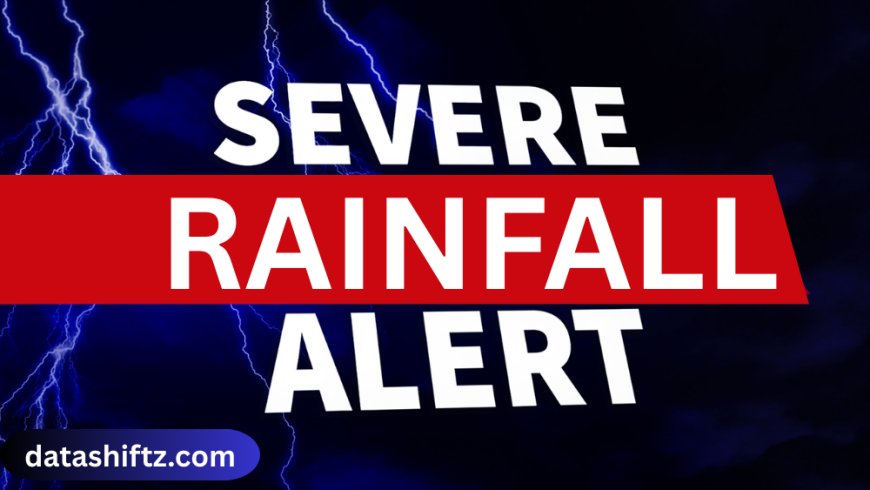Severe Rainfall Alert: Understanding Risks and Safety Measures

Introduction
Severe rainfall alerts are critical warnings issued by meteorological departments to inform the public and authorities about potential heavy rainfall events. These alerts aim to minimize damage to life, property, and infrastructure by ensuring timely preparedness. With climate change and unpredictable weather patterns, severe rainfall events have become more frequent, making awareness and planning essential. This article delves into the causes, impacts, safety measures, and guidelines associated with severe rainfall alerts.
Causes of Severe Rainfall
Meteorological Factors
Severe rainfall occurs due to multiple atmospheric and environmental conditions, including:
-
Monsoon Systems: Seasonal winds bringing prolonged rainfall, common in tropical regions.
-
Depressions and Cyclones: Low-pressure systems causing heavy precipitation over short periods.
-
Western Disturbances: In certain regions, these weather patterns bring rainfall in winter months.
-
Local Convection: Rapid heating of the land can cause thunderstorms and heavy localized rainfall.
Climate Change Impacts
-
Rising global temperatures increase atmospheric moisture, leading to intense rainfall events.
-
Erratic monsoon patterns result in unexpected floods and landslides, affecting vulnerable areas.
-
Urbanization reduces natural drainage, increasing the risk of waterlogging and urban floods during heavy rainfall.
Impacts of Severe Rainfall
Severe rainfall has wide-ranging effects on communities, infrastructure, and the environment:
Human and Social Impacts
-
Loss of life due to flooding and landslides.
-
Displacement of families and communities.
-
Disruption in education, healthcare, and public services.
Economic and Infrastructure Impacts
-
Damage to roads, bridges, and railways.
-
Destruction of crops, leading to agricultural losses.
-
Increased cost for emergency response and rehabilitation.
Environmental Impacts
-
Soil erosion and landslides in hilly areas.
-
Overflowing rivers and reservoirs, causing ecological disruptions.
-
Pollution of water sources due to runoff and debris.
Common Impacts of Severe Rainfall
| Sector | Impact Details |
|---|---|
| Human Safety | Flooding, injuries, fatalities |
| Infrastructure | Damaged roads, bridges, electricity outages |
| Agriculture | Crop damage, loss of livestock, reduced yield |
| Economy | Business disruption, increased recovery costs |
| Environment | Landslides, water pollution, soil erosion |
Safety Measures During Severe Rainfall
Before Rainfall
-
Monitor weather updates from official meteorological departments.
-
Prepare emergency kits with essentials like water, food, medicines, and flashlights.
-
Ensure drainage systems around homes are clean and functional.
-
Identify safe zones and evacuation centers in case of flooding.
During Rainfall
-
Avoid venturing outdoors unless necessary.
-
Stay away from flooded roads, rivers, and low-lying areas.
-
Keep electronic devices charged and maintain communication channels.
-
Follow instructions from local authorities and disaster management teams.
After Rainfall
-
Avoid drinking contaminated water and ensure proper sanitation.
-
Report damaged infrastructure to relevant authorities.
-
Assist vulnerable neighbors, including elderly and children, in recovering from the disaster.
-
Participate in community clean-up and rehabilitation efforts if safe.
Key Guidelines for Severe Rainfall Preparedness
-
Stay Informed: Follow official alerts via TV, radio, and mobile apps.
-
Emergency Supplies: Stock water, non-perishable food, first aid kits, and essential medications.
-
Evacuation Plans: Know the nearest safe zones and evacuation routes.
-
Protect Documents: Keep important documents in waterproof bags.
-
Home Safety: Clear drains, secure loose items, and check rooftops.
-
Avoid Risky Areas: Do not cross flooded roads or bridges.
-
Community Coordination: Assist neighbors and participate in local preparedness programs.
-
Health Precautions: Prevent waterborne diseases by boiling water and maintaining hygiene.
-
Vehicle Safety: Avoid driving through waterlogged streets.
-
Stay Calm: Follow authorities’ guidance and maintain communication with family and friends.
Role of Authorities and Disaster Management
-
Meteorological Departments: Issue timely alerts, track rainfall intensity, and forecast floods.
-
Disaster Response Teams: Provide immediate rescue, medical aid, and relief supplies.
-
Local Governments: Implement evacuation plans, maintain shelters, and restore essential services.
-
Community Organizations: Educate the public, distribute resources, and coordinate volunteers.
Example: Government Alert System
| Type of Alert | Description | Action Required |
|---|---|---|
| Yellow Alert | Heavy rainfall likely in 24-48 hours | Stay updated, prepare emergency kits |
| Orange Alert | Very heavy rainfall expected | Avoid travel, secure property |
| Red Alert | Extremely heavy rainfall, high flood risk | Evacuate if advised, follow authorities |
Future Preparedness and Technology
Advanced Weather Forecasting
-
Use of satellites, radar, and AI models for accurate rainfall prediction.
-
Real-time monitoring of rivers and reservoirs to prevent sudden floods.
Urban Planning and Infrastructure
-
Improved drainage systems and flood-resistant urban design.
-
Construction of retention ponds, levees, and embankments to manage excess water.
Community Awareness
-
Regular disaster drills in schools and workplaces.
-
Public education campaigns on flood preparedness and climate change impacts.
Conclusion
Severe rainfall alerts are crucial in safeguarding lives, property, and the environment. With climate change intensifying extreme weather events, understanding the causes, impacts, and safety measures is essential for every individual and community. Timely alerts, proper preparedness, and coordinated response efforts can significantly reduce the risks associated with heavy rainfall. By staying informed, following guidelines, and supporting community initiatives, we can ensure safety and resilience in the face of severe rainfall events.






























